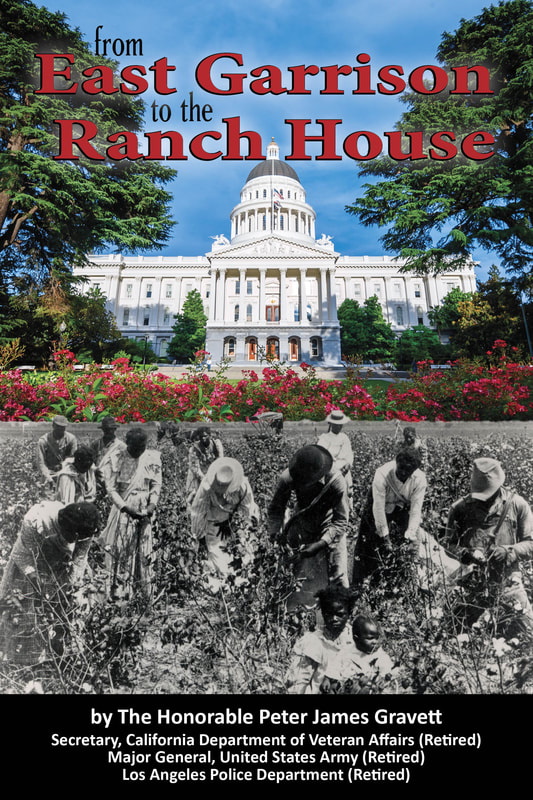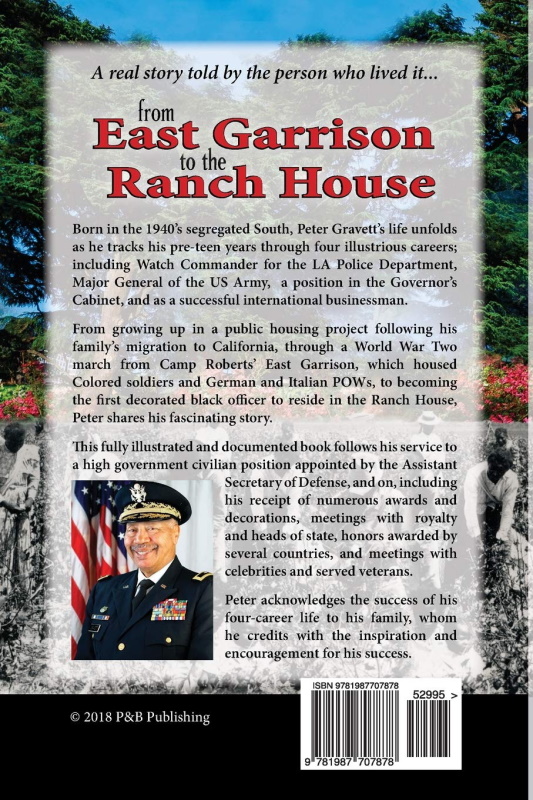Everyone has a story to tell and they are all different so what follows is my story as best as I can tell it. I always knew that should I eventually write my story the title would chronicle my journey from East Garrison to the Ranch House and even extending far beyond. Both East Garrison and the Ranch House are located at Camp Roberts, California as will later be described in detail with this treatise. This was important in order for the reader to grasp a full appreciation of the title.
Bishop T.D. Jakes writes in his book Destiny “The day comes when every person must leave the security of the nest and pursue their destiny.” MY destiny did not emanate from a classroom at the various prestigious colleges and universities attended but from trials experienced growing up, learning from two parents, 10 siblings raised in a three bedroom house and the tribulations of observing my parents sacrifice their entire being for their children’s future. Bishop Jakes continues in his book…”education is no replacement for having been in the trenches.”
East Garrison is at Camp Roberts, where the first part of my story unfolds and sets the stage. The most historic building on the post, however, is the Ranch House located approximately seven miles into the post’s interior from the main gate and about ten miles from East Garrison.
Enemy Prisoner of War Compound
Contained at East Garrison were compounds for Italian and German prisoners of war housed in barracks constructed for them by Colored soldiers while themselves were housed in tents. Just as in other military communities around the country, enemy prisoners of war were extended privileges not given to American Colored troops.
In Arkansas my father worked at a number of jobs through he was primarily a sharecropper. The main crop grown was cotton.
When my parents had saved sufficient funds to purchase one way train fare for two adults and their then eight children they notified Mr. Alexander of the family’s intention to move west. This infuriated the plantation owner who used various deceptive tactics and nefarious ruses to persuade our family to remain “down on the farm.”
During the Great Migration from the south during the 1930’s and 1940’s rather than head north to Chicago or Detroit my relatives made the decision to migrate west to Southern California. Perhaps this was Devine intervention as there was an abundance of jobs a few years later and the weather was nicer. During this time in our nation’s history both parts of the country were highly segregated.
I joined the Army National Guard in 1959. San Pedro had a National Guard Armory just one block from the high school which I walked passed every day. I met with the White Sergeant on duty and expressed my intentions to join but he advised that I could not join that unit because all of the positions were filled. He directed me to the next nearest unit which was in Torrance, CA about 12 miles distance. The Sergeant there referred me to the Exposition Park Armory as they were certain to have opening.
The Warrant Officer then explained that I should have never gone to either place to enlist because they were White units and this was a Negro unit; “our unit” as I recall him saying. This was in 1959 and I had not realized that even though the US Army had integrated 11 years earlier the National Guard in California, and in most states, was still segregated, some states barring Negro’s from the National Guard altogether I learned.
My two lifelong ambitions were to become both a police officer and a soldier and I eventually achieved both.
Just prior to my commissioning from OCS all candidates appeared before a “Branching Board” to determine which branch in the Army they will be commissioned. Generally each candidate will list their top three choices in priority but it is up to the needs of the service which branch they will be assigned.
I overheard a casual remark by a Board Member suggesting that I not be branched Field Artillery as “Field Artillery requires a lot of mathematics and computations and blacks generally lack that ability.” This was in 1968 and my minor in college was criminalistics requiring several courses of advanced mathematics and I was very familiar with the tactical and operational employment of Artillery in support of Infantry and Armor operations.
Additionally, if that person had studied military history, past and current, he would have known that black soldiers had served in Field Artillery units for almost 200 years.
While serving as a Brigade Commander in 1994, I was directed to attend a strategic planning meeting at Travis Air Force Base in Northern California. At the meeting there were three Army General and two Air Force Generals, as I recall. Noticeably I was the only Colonel.
Right away General Bozeman began by announcing the purpose of the meeting was to announce that I had been selected for the rank of Brigadier General.
Much of the lead-in to this book and indeed the title itself had to do with the Ranch house and its’ geographical setting on the footprint of Camp Roberts. In its modern day use was exclusively occupied by General officers.
In August 1999, one month after taking command of the 40th Infantry Division (Mechanized)I deployed to Camp Roberts.
I was now the first African American Division Commander to occupy the Ranch House as its official resident.
Very late on a Wednesday evening in April 2011 I received a telephone call from the Office of California’s Governor Jerry Brown. The caller inquired if I would be interested in serving in the Governor’s Cabinet.
Blanche and I arrived at the location where I met with the Governor and his wife. When we arrived home very late that Thursday evening, at almost midnight, I received another telephone call from the Appointment Secretary advising me the Governor had made a decision to appoint me and would I accept. When I replied in the affirmative, I was told that I would be starting the next morning, Friday, in about eight hours.

